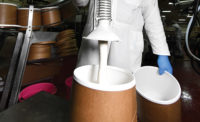You won’t find any fancy feeder hoppers or blenders in Praline’s Inc.’s Wallingford, Conn., ice cream processing, distribution and headquarters facility. The company believes that the old-fashioned methods still yield the best-tasting ice cream. So plant employees start with a high-quality base, then mix in the variegates and inclusions by hand.
These champions of quality also make a number of the ice cream syrups, purees and inclusions from scratch in the facility’s kitchen. These ingredients go into the 56 core and 13 seasonal ice cream (and sherbet, frozen yogurt and sorbet) flavors the facility produces for 11 franchised Praline’s ice cream parlors, about a dozen independent ice cream parlors and a foodservice distributor. They also go into a number of different ice cream pies and ice cream cakes created for those customers.
“We like to have as much control over quality as we can,” explained Jalmar De Dios, chief strategy and marketing officer.
For example, employees puree bananas destined for the banana ice cream, he said, and also create a decadent peanut butter topping that goes into several ice cream flavors. And they hand-make the Mounds-like chocolate and coconut candy that gives the coconut bar ice cream its yummy appeal. Employees then break up the candy and, like they do with the other inclusions they use, freeze it before mixing it the ice cream.
A matter of technique
Before any hand-mixing commences, two employees use four ice cream machines — three with a 22-quart capacity and one with a 44-quart capacity — to transform fresh cream, fresh milk, flavors and other ingredients into a creamy ice cream base flavor. (A mixer is used to blend the cocoa base before it goes into the machine.) During production, the two employees typically will each create a different base via the smaller machines; that base serves as the starting point for a family of ice cream flavors, noted Maria De Dios, executive chef and product officer, who is also Jalmar De Dios’ sister. (During Dairy Foods’ visit, the two bases in production were a banana flavor and a sweet cream flavor.)
The large ice cream machine generally is reserved for the mass production of solid flavors — flavors sans variegates and inclusions — such as vanilla, chocolate and raspberry, she added.
Once the base flavor is ready, the hard work really begins. Each employee starts with one of the 2.5-gallon containers in which the ice cream is delivered, filling it halfway with the ice cream. He or she then uses a sturdy spatula to carefully mix in the variegate and/or inclusions. The employee then fills the container with more ice cream before mixing in more variegate and/or inclusions. The process is much more difficult than it looks.
“It takes about a year to become an ice cream maker,” Jalmar De Dios said. “The technique is hard to master, especially for a ripple.”
When the hand-mixing process is complete, the ice cream container is covered with wax paper and placed into one of two hardening freezers in the back of the facility. The freezers are kept at a temperature between -20 and -30 degrees Fahrenheit, he noted.
After hardening, the product is transferred to the largest of the facility’s three freezers, Jalmar De Dios said. From there, Praline’s transports it directly to one of the ice cream parlors, or the distributor picks it up during a regular run.
The process is similar, albeit a bit longer, for the ice cream cakes and pies, he said. In fact, most of the pies undergo a two-day process for placing and hardening the layers. And pies requiring garnishes — for example, the coconut pies, which boast coconut flakes — require a three-day process.
Safety counts, too
Praline’s devotes as much attention to product safety as it does to product quality. The facility follows a specific list of cleaning steps, as well as state-mandated testing to ensure cleaning thoroughness, Juan De Dios, chief operations officer and sibling to Jalmar and Maria De Dios, noted.
The machines are cleaned, rinsed and sanitized multiple times each day, he said, “before they are used and after they are used [for each flavor]. Everything has to be taken off the tables, which are wiped clean with sanitizers, and we sweep and mop every day.”
Working as a team, employees then verify that they accomplished everything on the cleaning list, Maria De Dios added.
State inspectors also perform regular testing on the ice cream. And the facility scrutinizes supplier-provided products, too. Incoming products are evaluated, and if something appears to be off in terms of food safety or quality, they are rejected, Juan De Dios said. The facility then contacts the supplier to address and remedy the situation.
Promoter of teamwork
During the offseason, the Praline’s facility operates with only a handful of employees. But it augments that staff as summer approaches, adding both kitchen and back-of-the-house/delivery workers to the one-shift operation. During that high season, the facility typically moves more than 11,000 of the 34,000-plus boxes of ice cream it supplies to customers throughout the year. (It also supplies 2,500 ice cream pies and 2,600 ice cream cakes each year.)
But both scenarios require a lot of teamwork for success, Maria De Dios explained.
“We work by [ice cream base] families, making, for example, a big vanilla family with the cookies, chocolate chips and other ingredients,” she said. “And then we do the chocolate family. We try to focus on mass production to build a big stock before the season starts.”
Employee training is critical, too.
“We do a lot of employee training when someone’s new,” noted Juan De Dios. “We have formal training in both product safety and personal safety.”
The longer-term employees also serve as mentors, he added, and help cross-train new workers on multiple tasks. That cross-training is crucial in an operation with a limited number of employees.
“Whenever someone needs help in a certain department, we’ll all jump in,” noted Donna Torre, Praline’s president, who cofounded the company with her late husband Joe. “I think that’s what makes us unique.”
That willingness to wear many hats also will come handy as Praline’s moves forward with its new expansion strategy. When the financial crisis hit in 2008, the company, like many others, was hit hard. But the situation forced it to re-evaluate its relationships and to determine what was working — and say goodbye to what wasn’t, Jalmar De Dios said. Ultimately, Praline’s opted to get out of the private labeling and wholesale businesses to focus on its core strength: making high-quality hard ice cream products.
“We’ve steadied our ship, and now we’re ready to focus on growth,” he stressed. (See “Eye on Expansion.")
Up to the challenges
Although Praline’s processing facility/warehouse is only 5,000 square feet, Torre said it could handle almost a doubling of the current production with the addition of another shift. The existing freezer space certainly could accommodate the expansion.
But the company will need to address a few challenges if it is to avoid unnecessary growing pains. One of those is securing the right plant-level employees. They must be able to follow the rules related to quality and safety, Maria De Dios noted.
It’s already difficult to find good workers, particularly drivers, for the busy high season, Juan De Dios added. They are front-facing with customers, so if they aren’t friendly, it makes a poor impression and potentially hurts business.
But the company’s friendly approach here should work in its favor as it grows.
“We look at the business as a family, even though we’re not all family,” Juan De Dios explained. “That’s how we treat everyone who works here.”
Another challenge is the likelihood that a production expansion will require the addition of new equipment. For now, Juan De Dios takes advantage of some of the downtime in the off season to review new equipment videos and research new equipment on the Internet.
“We evaluate it to see if we really need it and how it is going to work for us,” he said. “Because if it’s not going to work for us, why even bring it in?”
Although it’s not specifically related to expansion, yet another challenge lies in maintaining the high quality of the ice cream at a price that’s palatable to Praline’s customers. Right now, the market is flooded with ice cream products that are loaded with a lot of crazy flavors and ingredients, Maria De Dios pointed out. But testing will show that the products’ quality is subpar.
“We put a lot of time and effort into researching new flavors,” she stressed. “We want to ensure that as we are evolving with the market trends, we don’t lose our way.”










